Highly Stable Passively Q-Switched Erbium-Doped All-Fiber Laser Based on Niobium Diselenide Saturable Absorber
Abstract
1. Introduction
2. Preparation and Characterization of NbSe2
2.1. Preparation of NbSe2
2.2. Characterization of NbSe2 SA Properties
3. Experimental Results of Optical Modulation and Discussions
4. Conclusions
Author Contributions
Funding
Institutional Review Board Statement
Informed Consent Statement
Data Availability Statement
Conflicts of Interest
Sample Availability
References
- Laroche, M.; Chardon, A.M.; Nilsson, J.; Shepherd, D.P.; Clarkson, W.A.; Girard, S.; Moncorge, R. Compact diode-pumped passively Q-switched tunable Er-Yb double-clad fiber laser. Opt. Lett. 2002, 27, 1980–1982. [Google Scholar] [CrossRef] [PubMed]
- Richardson, D.J.; Nilsson, J.; Clarkson, W.A. High power fiber lasers: Current status and future perspectives. J. Opt. Soc. Am. B 2010, 27, B63–B92. [Google Scholar] [CrossRef]
- Ahmad, H.; Muhammad, F.D.; Chang, H.P.; Thambiratnam, K. Dual-wavelength fiber lasers for the optical generation of microwave and terahertz radiation. IEEE J. Sel. Top. Quant. 2014, 20, 166–173. [Google Scholar] [CrossRef]
- Aziz, N.A.; Latiff, A.A.; Lokman, M.Q.; Hanafi, E.; Harun, S.W. Zinc oxide-based Q-switched erbium-doped fiber laser. Chin. Phys. Lett. 2017, 34, 43–45. [Google Scholar] [CrossRef]
- Ahmad, H.; Reduan, S.A. Passively Q-switched s-band thulium fluoride fiber laser with multi-walled carbon nanotube. Chin. Opt. Lett. 2018, 16, 010609-1–010609-5. [Google Scholar] [CrossRef]
- Rosdin, R.Z.R.R.; Ahmad, F.; Ali, N.M.; Harun, S.W.; Arof, H. Q-switched Er-doped fiber laser with low pumping threshold using graphene saturable absorber. Chin. Opt. Lett. 2014, 12, 091404. [Google Scholar] [CrossRef]
- Dong, X.; Tian, J.; Yu, Z.; Song, Y. Q-switched Er-doped fiber laser with single-walled carbon nanotube saturable absorber by evanescent field. Chin. Opt. Lett. 2014, 12, S21402. [Google Scholar] [CrossRef][Green Version]
- Ahmad, H.; Aidit, S.N.; Ooi, S.I.; Tiu, Z.C. Tunable passively Q-switched ytterbium-doped fiber laser with mechanically exfoliated gase saturable absorber. Chin. Opt. Lett. 2018, 16, 020014. [Google Scholar] [CrossRef]
- Liu, M.; Liu, W.; Yan, P.; Fang, S.; Teng, H.; Wei, Z. High-power MoTe2-based passively Q-switched erbium-doped fiber laser. Chin. Opt. Lett. 2018, 16, 020007. [Google Scholar]
- Novoselov, K.S.; Geim, A.K.; Morozov, S.V.; Jiang, D.; Katsnelson, M.I.; Grigorieva, I.V.; Dubonos, S.V.; Firsov, A.A. Two-dimensional gas of massless Dirac fermions in graphene. Nature 2005, 438, 197–200. [Google Scholar] [CrossRef]
- Zhang, Y.B.; Tan, Y.W.; Stormer, H.L.; Kim, P. Experimental observation of the quantum Hall effect and Berry’s phase in graphene. Nature 2005, 438, 201–204. [Google Scholar] [CrossRef]
- Mak, K.F.; Lee, C.; Hone, J.; Shan, J.; Heinz, T.F. Atomically thin MoS2: A new direct-gap semiconductor. Phys. Rev. Lett. 2010, 105, 136805.1–136805.4. [Google Scholar] [CrossRef] [PubMed]
- Splendiani, A.; Liang, S.; Zhang, Y.B.; Li, T.S.; Kim, J.; Chim, C.Y.; Galli, G.; Wang, F. Emerging photoluminescence in monolayer MoS2. Nano Lett. 2010, 10, 1271–1275. [Google Scholar] [CrossRef] [PubMed]
- Lu, S.; Du, L.; Kang, Z.; Li, J.; Huang, B.; Jiang, G. Stable dissipative soliton generation from Yb-doped fiber laser modulated via evanescent field interaction with gold nanorods. IEEE Photon. J. 2018, 10, 1–8. [Google Scholar] [CrossRef]
- Khaz Ae Inezhad, R.; Kassani, S.H.; Paulson, B.; Jeong, H.; Gwak, J.; Rotermund, F. Ultrafast nonlinear optical properties of thin-solid DNA film and their application as a saturable absorber in femtosecond mode-locked fiber laser. Sci. Rep. 2017, 7, 41480. [Google Scholar] [CrossRef] [PubMed]
- Kou, L.; Frauenheim, T.; Chen, C. Nanoscale multilayer transition-metal dichalcogenide heterostructures: Band gap modulation by interfacial strain and spontaneous polarization. J. Phys. Chem. Lett. 2013, 4, 1730–1736. [Google Scholar] [CrossRef] [PubMed]
- Yin, Z.; Li, H.; Li, H.; Jiang, L.; Shi, Y.; Sun, Y.; Lu, G.; Zhang, Q.; Chen, X.; Zhang, H. Single-layer MoS2 phototransistors. ACS Nano 2012, 6, 74–80. [Google Scholar] [CrossRef] [PubMed]
- Huang, Z.; Zhang, W.; Zhang, W. Computational search for two dimensional MX2 semiconductors with possible high electron mobility at room temperature. Materials 2016, 9, 716. [Google Scholar] [CrossRef]
- Xia, H.D.; Li, H.P.; Lan, C.Y.; Li, C.; Zhang, X.X.; Zhang, S.J.; Liu, Y. Ultrafast erbium-doped fiber laser mode-locked by a CVD-grown molybdenum disulfide (MoS2) saturable absorber. Opt. Express 2014, 22, 17341–17348. [Google Scholar] [CrossRef]
- Mao, D.; Wang, Y.; Ma, C.; Han, L.; Jiang, B.; Gan, X.; Hua, S.; Zhang, W.; Mei, T.; Zhao, J. WS2 mode-locked ultrafast fiber laser. Sci. Rep. 2015, 5, 7965. [Google Scholar] [CrossRef]
- Luo, Z.Q.; Li, Y.Y.; Zhong, M.; Huang, Y.Z.; Wan, X.J.; Peng, J.; Weng, J. Nonlinear optical absorption of few-layer molybdenum diselenide (MoSe2) for passively mode-locked soliton fiber laser. Photonics Res. 2015, 3, A79–A86. [Google Scholar] [CrossRef]
- Mao, D.; She, X.Y.; Du, B.B.; Yang, D.X.; Zhang, W.D.; Song, K.; Cui, X.Q.; Jiang, B.Q.; Peng, T.; Zhao, J.L. Erbium-doped fiber laser passively mode locked with few-layer WSe2/ MoSe2 nanosheets. Sci. Rep. 2016, 6, 23583. [Google Scholar] [CrossRef] [PubMed]
- Zhang, M.; Hu, G.; Hu, G.; Howe, R.; Chen, L.; Zheng, Z. Yb- and Er-doped fiber laser Q-switched with an optically uniform, broadband WS2 saturable absorber. Sci. Rep. 2015, 5, 11453–11461. [Google Scholar] [CrossRef] [PubMed]
- Patel, K.; Solanki, G.K.; Patel, K.D.; Pataniya, P.; Tannarana, M.; Chauhan, P. Optoelectronic devices based on chemical vapour transport grown NbSe2 crystals. AIP Conf. Proc. 2019, 2100, 020130-1–020130-4. [Google Scholar]
- Le, Q.V.; Choi, J.Y.; Kim, S.Y. Recent advances in the application of two-dimensional materials as charge transport layers in organic and perovskite solar cells. Flatchem 2017, 2, 1–13. [Google Scholar]
- Bachmann, R.; Kirsch, H.C.; Geballe, T.H. Optical properties and superconductivity of NbSe2. Solid State Commun. 1971, 9, 57–60. [Google Scholar] [CrossRef]
- Shi, Y.; Li, W.; Lu, W. Passively Q-switched Er-doped fiber laser based on NbSe2 quantum dot saturable absorber. In Proceedings of the Asia Communications and Photonics Conference (ACP), Hangzhou, China, 26–29 October 2018. [Google Scholar]
- Shi, Y.H.; Long, H.; Liu, S.X.; Tsang, Y.H.; Wen, Q. Ultrasmall 2D NbSe2 based quantum dots used for low threshold ultrafast lasers. J. Mater. Chem. C 2018, 6, 12638–12642. [Google Scholar] [CrossRef]
- Yang, H. Niobium diselenide nanosheets for a vector soliton fiber laser. J. Mater. Chem. C 2020, 8, 14954–14958. [Google Scholar] [CrossRef]
- Chen, L.L.; Du, L.; Li, J.; Yang, L.L.; Yi, Q.; Zhao, C.J. Dissipative soliton generation from Yb-doped fiber laser modulated by mechanically exfoliated NbSe2. Front. Phys. 2020, 8, 1–7. [Google Scholar] [CrossRef]
- Wang, H.; Huang, X.; Lin, J.; Cui, J.; Chen, Y.; Zhu, C. High-quality monolayer superconductor NbSe2 grown by chemical vapour deposition. Nat. Commun. 2017, 8, 394. [Google Scholar] [CrossRef]
- Chen, B.H.; Zhang, X.Y.; Wu, K.; Wang, H.; Wang, J.; Chen, J.P. Q-switched fiber laser based on transition metal dichalcogenides MoS2, MoSe2, WS2, and WSe2. Opt. Express 2015, 23, 26723. [Google Scholar] [CrossRef] [PubMed]
- Wang, J.; Luo, Z.; Zhou, M.; Ye, C.; Fu, H.; Cai, Z.; Cheng, H.; Xu, H.; Qi, W. Evanescent-light deposition of graphene onto tapered fibers for passive Q-Switch and mode-locker. IEEE Photon. J. 2012, 4, 1295–1305. [Google Scholar] [CrossRef]
- Li, L.; Lv, R.D.; Liu, S.C.; Wang, Y.G.; Chen, Z.D.; Wang, J. Transition metal dichalcogenide (WS2 and MoS2) saturable absorbers for Q-switched Er-doped fiber lasers. Laser Phys. 2018, 28, 055106. [Google Scholar] [CrossRef]
- Guo, L.; Wen, J.G. Numerically Analysis on the Role of the Modulation Depth in an All-Fiber Erbium-Doped Laser with Normal Cavity Dispersion. Appl. Mech. Mater. 2013, 411–414, 761–764. [Google Scholar] [CrossRef]
- Xu, X.; Jiang, M.; Li, D.; Wang, R.D.; Ren, Z.Y.; Bai, J.T. Passive Q-switching based on ReS2 saturable absorber in Er-doped fiber laser at 1532 nm. Opt. Quant. Electron. 2018, 50, 39. [Google Scholar] [CrossRef]
- Liu, S.C.; Zhang, Y.N.; Li, L.; Wang, Y.G.; Lv, R.D.; Wang, X.; Chen, Z.D.; Wei, L.L. Er-doped Q-switched fiber laser with a black phosphorus/polymethyl methacrylate saturable absorber. Appl. Opt. 2018, 57, 1292–1295. [Google Scholar] [CrossRef]
- Hu, P.; Liu, Y.; Guo, L.P.; Ge, X.L.; Liu, X.J.; Yu, L.J.; Liu, Q.H. Passively Q-switched erbium-doped fiber laser based on antimonene as saturable absorber. Appl. Opt. 2019, 58, 7845. [Google Scholar] [CrossRef]

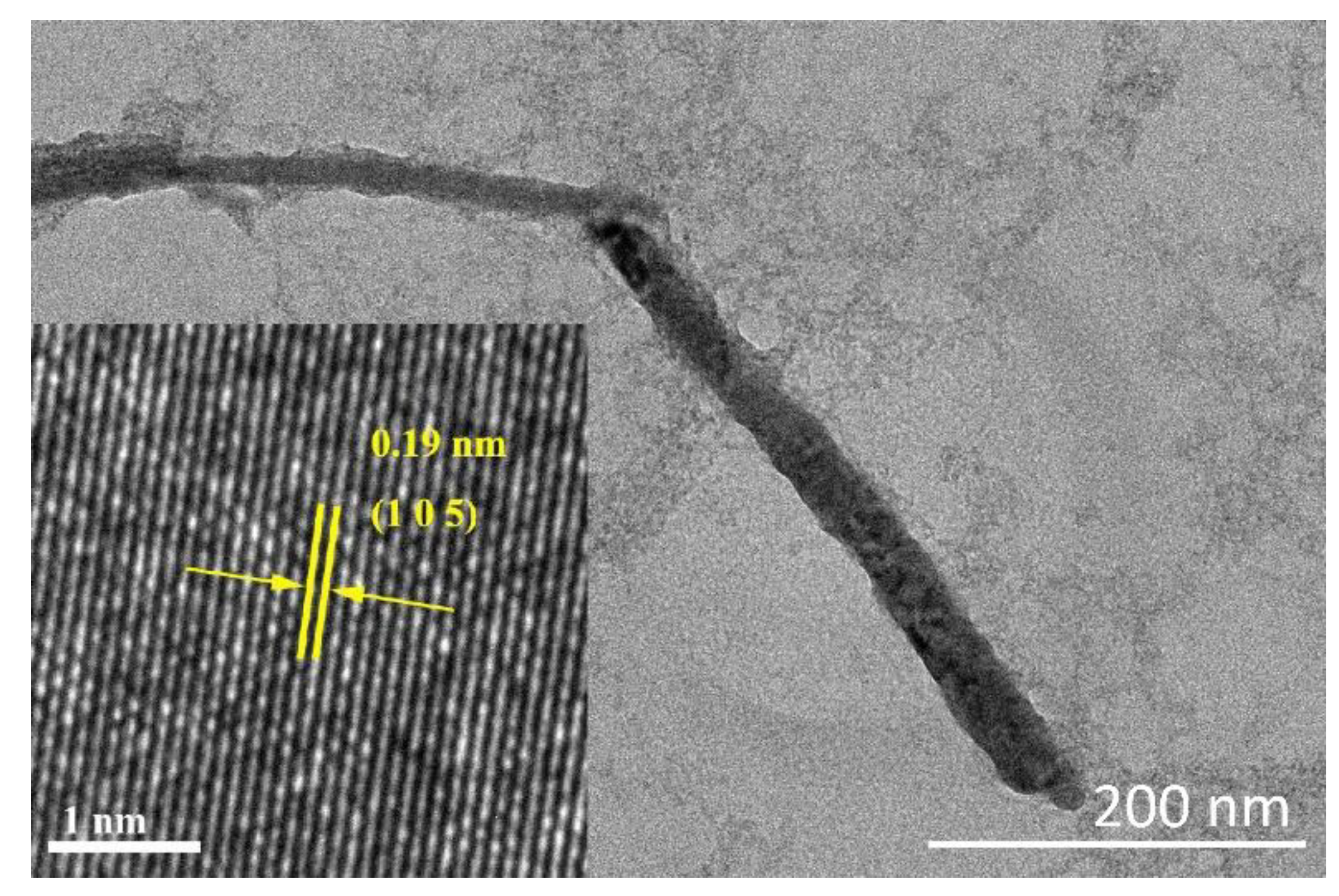
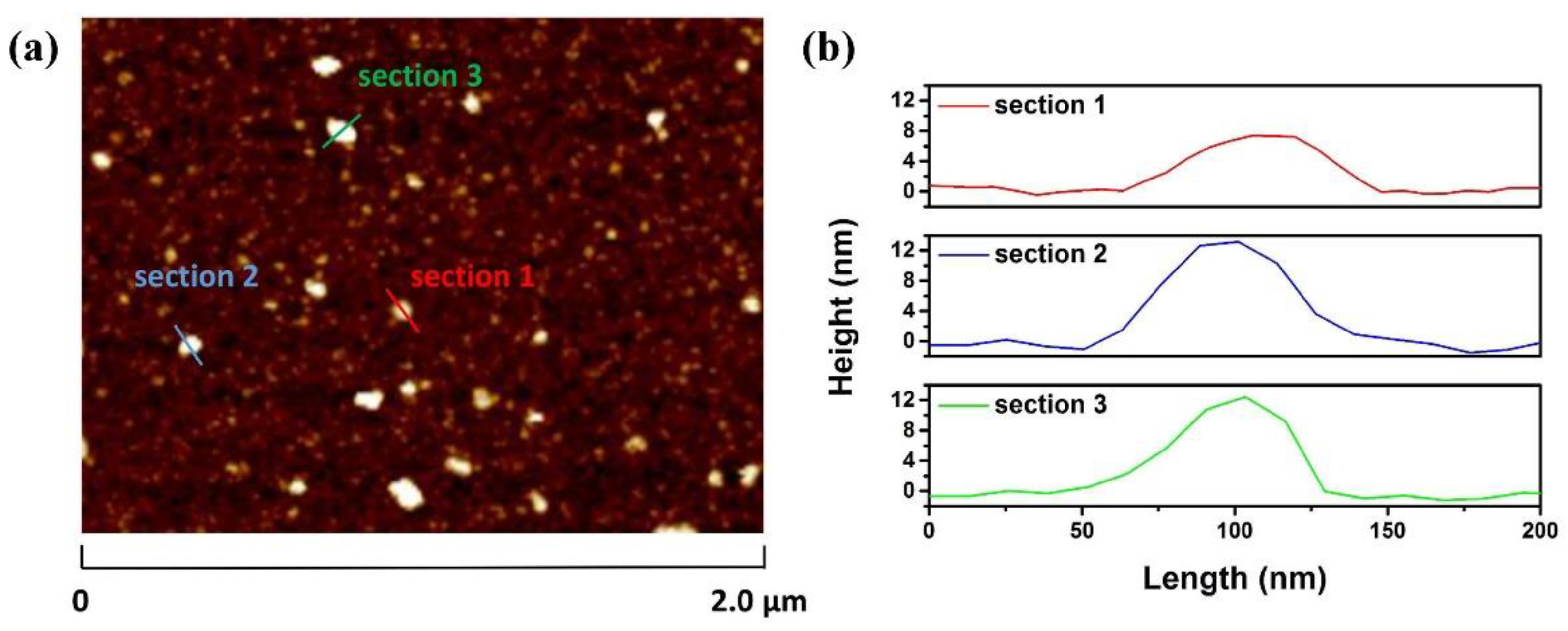
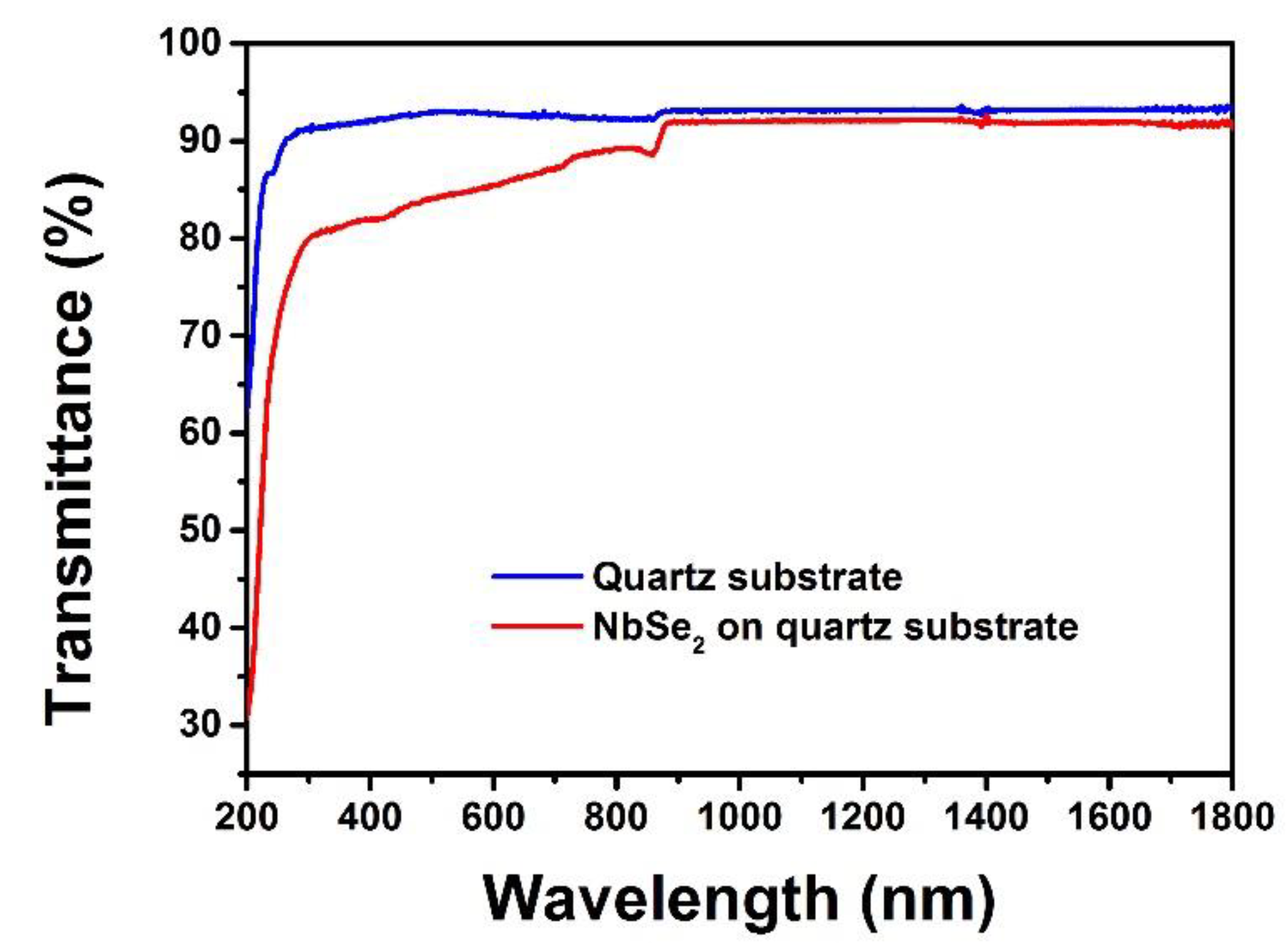

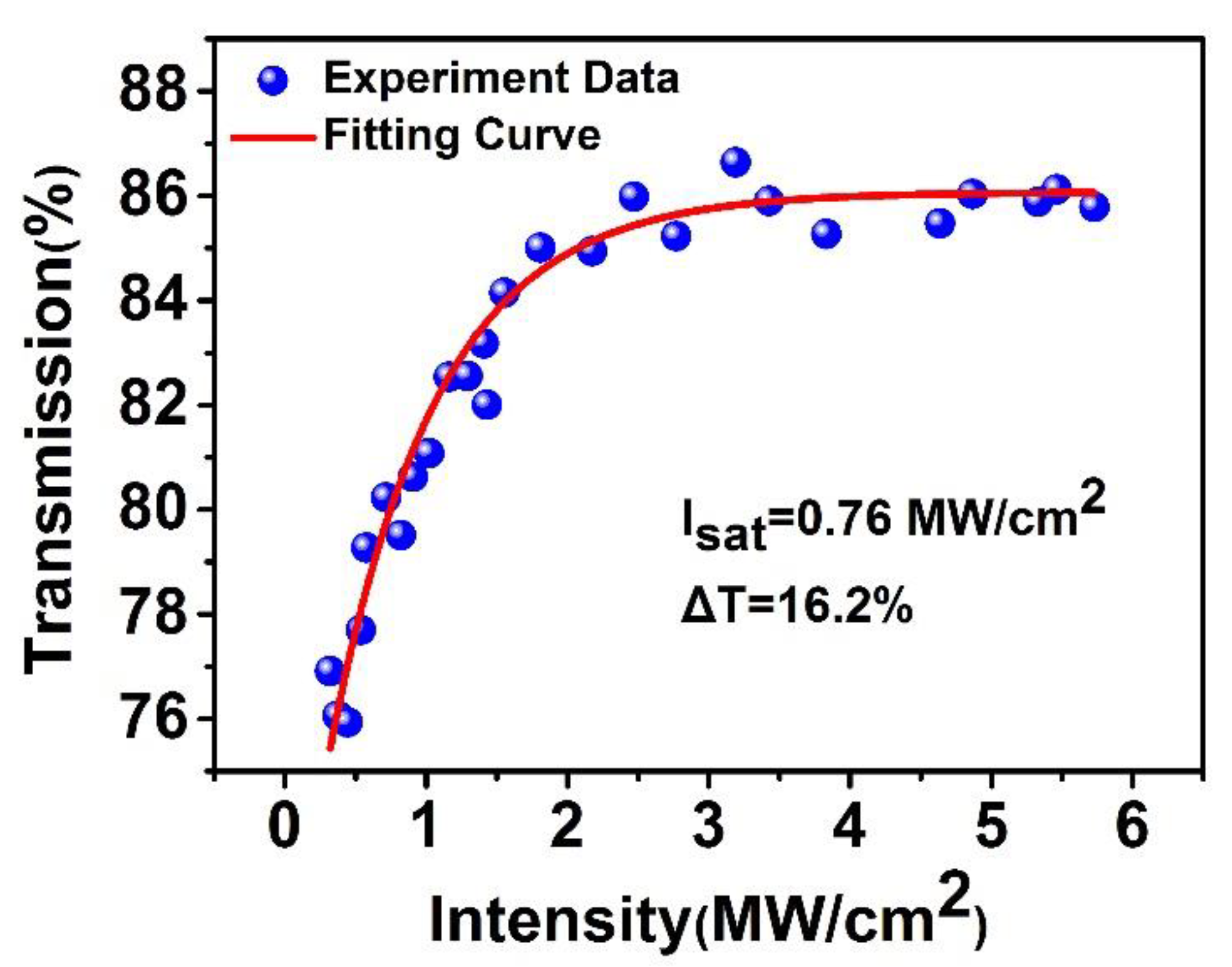

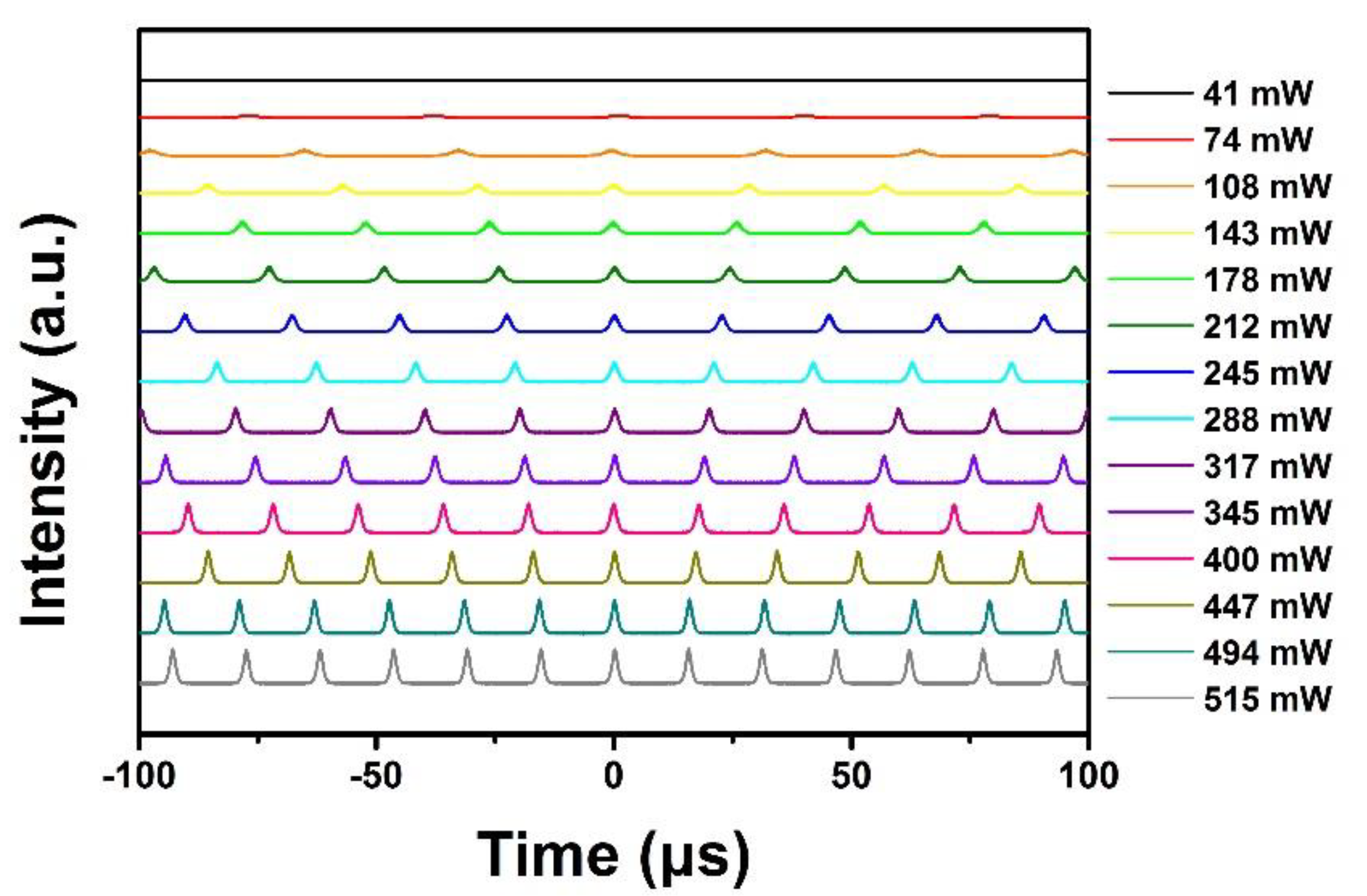
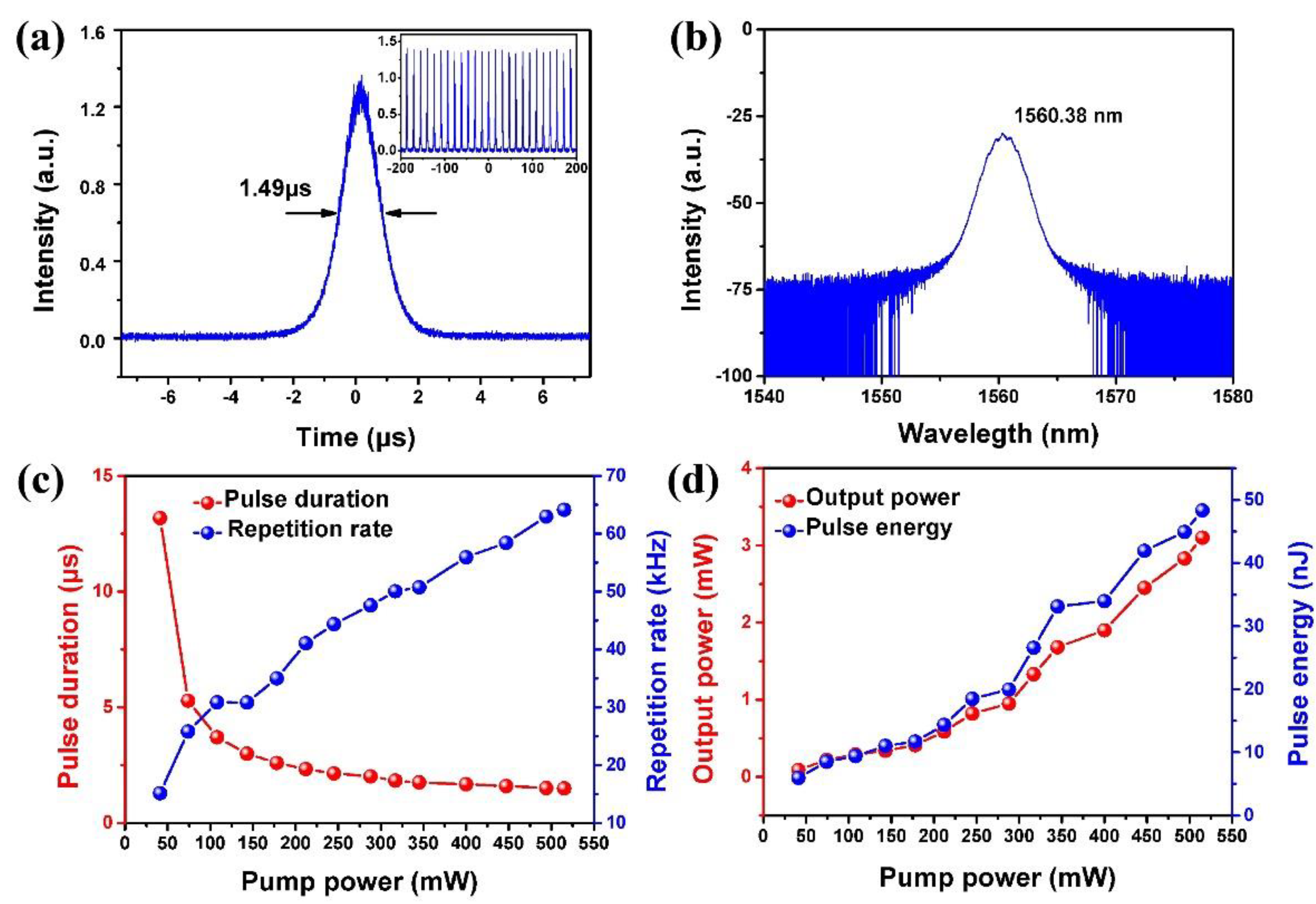
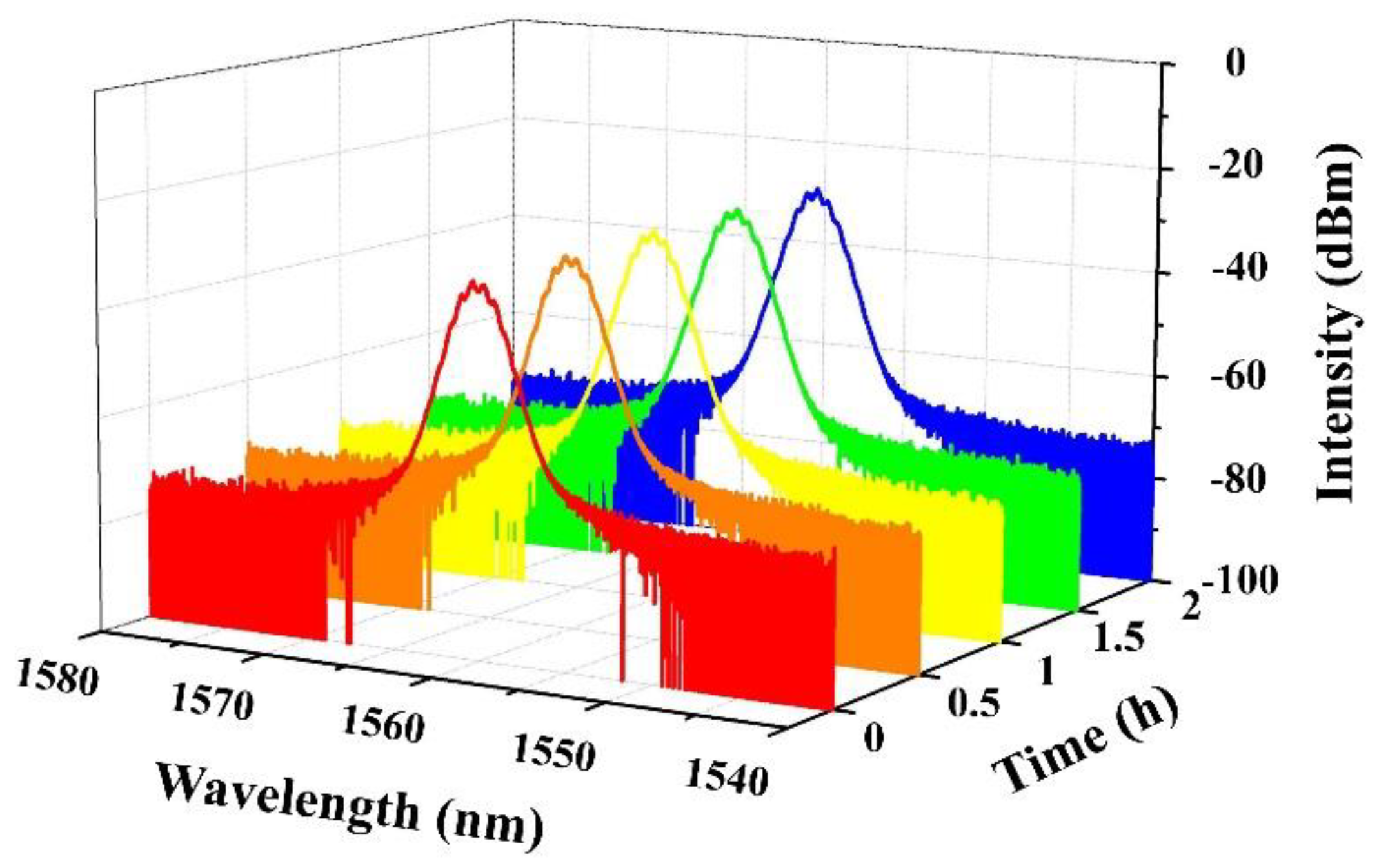
| SA | Wavelength (nm) | Pulse Width (μs) | Pulse Energy (nJ) | Max Output Power (mW) | Refs. |
|---|---|---|---|---|---|
| graphene | 1539.6 | 3.89 | 28.7 | 3.38 | [33] |
| MoS2 | 1560 | 3.97 | 131.52 | 6 | [34] |
| WS2 | 1560 | 3.71 | 126.96 | 4.82 | [34] |
| ReS2 | 1532 | 2.57 | 38 | 2.48 | [36] |
| BP | 1564.16 | 2.98 | 283.91 | 8.55 | [37] |
| antimonene | 1559.63 | 1.58 | 37.9 | 2.85 | [38] |
| NbSe2 QD | 1533 | 2.53 | 98.19 | 2.00 | [28] |
| NbSe2 | 1560.38 | 1.49 | 48.33 | 3.1 | This work |
Publisher’s Note: MDPI stays neutral with regard to jurisdictional claims in published maps and institutional affiliations. |
© 2021 by the authors. Licensee MDPI, Basel, Switzerland. This article is an open access article distributed under the terms and conditions of the Creative Commons Attribution (CC BY) license (https://creativecommons.org/licenses/by/4.0/).
Share and Cite
Hu, P.; Mao, J.; Nie, H.; Wang, R.; Zhang, B.; Li, T.; He, J.; Yang, K. Highly Stable Passively Q-Switched Erbium-Doped All-Fiber Laser Based on Niobium Diselenide Saturable Absorber. Molecules 2021, 26, 4303. https://doi.org/10.3390/molecules26144303
Hu P, Mao J, Nie H, Wang R, Zhang B, Li T, He J, Yang K. Highly Stable Passively Q-Switched Erbium-Doped All-Fiber Laser Based on Niobium Diselenide Saturable Absorber. Molecules. 2021; 26(14):4303. https://doi.org/10.3390/molecules26144303
Chicago/Turabian StyleHu, Ping, Jiajia Mao, Hongkun Nie, Ruihua Wang, Baitao Zhang, Tao Li, Jingliang He, and Kejian Yang. 2021. "Highly Stable Passively Q-Switched Erbium-Doped All-Fiber Laser Based on Niobium Diselenide Saturable Absorber" Molecules 26, no. 14: 4303. https://doi.org/10.3390/molecules26144303
APA StyleHu, P., Mao, J., Nie, H., Wang, R., Zhang, B., Li, T., He, J., & Yang, K. (2021). Highly Stable Passively Q-Switched Erbium-Doped All-Fiber Laser Based on Niobium Diselenide Saturable Absorber. Molecules, 26(14), 4303. https://doi.org/10.3390/molecules26144303








